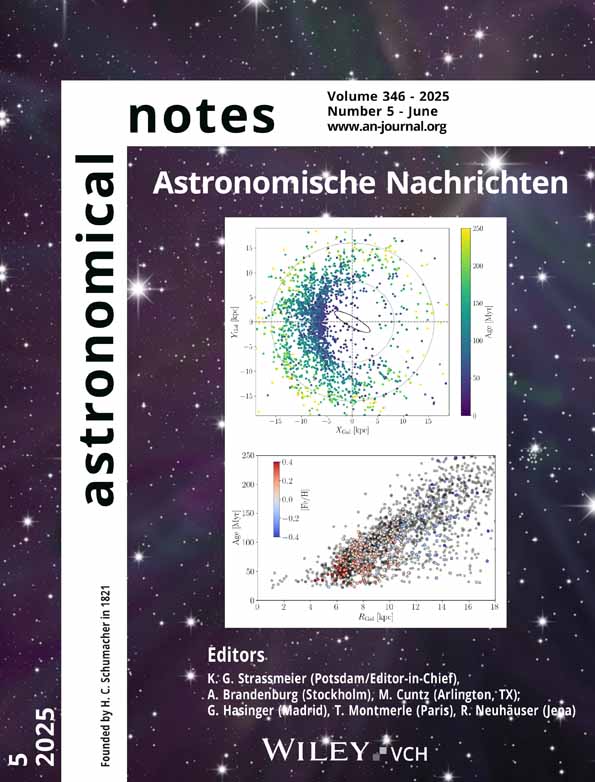Long-term radio behaviour of GPS sources and candidates
I. Torniainen
Metsähovi Radio Observatory, Helsinki University of Technology TKK, Metsähovintie 114, 02540 Kylmälä, Finland
Search for more papers by this authorA. Lähteenmäki
Metsähovi Radio Observatory, Helsinki University of Technology TKK, Metsähovintie 114, 02540 Kylmälä, Finland
Search for more papers by this authorT. Hovatta
Metsähovi Radio Observatory, Helsinki University of Technology TKK, Metsähovintie 114, 02540 Kylmälä, Finland
Search for more papers by this authorE. Nieppola
Metsähovi Radio Observatory, Helsinki University of Technology TKK, Metsähovintie 114, 02540 Kylmälä, Finland
Search for more papers by this authorM. Turunen
Metsähovi Radio Observatory, Helsinki University of Technology TKK, Metsähovintie 114, 02540 Kylmälä, Finland
Search for more papers by this authorM. Lainela
Tuorla Observatory, University of Turku, Väisälantie 20, 21500 Piikkiö, Finland
Search for more papers by this authorE. Valtaoja
Tuorla Observatory, University of Turku, Väisälantie 20, 21500 Piikkiö, Finland
Department of Physics, University of Turku, 20100 Turku, Finland
Search for more papers by this authorM.F. Aller
Department of Astronomy, University of Michigan, Ami Arbor, MI, 48190, USA
Search for more papers by this authorH.D. Aller
Department of Astronomy, University of Michigan, Ami Arbor, MI, 48190, USA
Search for more papers by this authorM. Mingaliev
Special Astrophysics Observatory, RAS, Nizhnij Arkhyz, Karachaevo-Cherkesia, 369167 Russia
Search for more papers by this authorS. Trushkin
Special Astrophysics Observatory, RAS, Nizhnij Arkhyz, Karachaevo-Cherkesia, 369167 Russia
Search for more papers by this authorI. Torniainen
Metsähovi Radio Observatory, Helsinki University of Technology TKK, Metsähovintie 114, 02540 Kylmälä, Finland
Search for more papers by this authorA. Lähteenmäki
Metsähovi Radio Observatory, Helsinki University of Technology TKK, Metsähovintie 114, 02540 Kylmälä, Finland
Search for more papers by this authorT. Hovatta
Metsähovi Radio Observatory, Helsinki University of Technology TKK, Metsähovintie 114, 02540 Kylmälä, Finland
Search for more papers by this authorE. Nieppola
Metsähovi Radio Observatory, Helsinki University of Technology TKK, Metsähovintie 114, 02540 Kylmälä, Finland
Search for more papers by this authorM. Turunen
Metsähovi Radio Observatory, Helsinki University of Technology TKK, Metsähovintie 114, 02540 Kylmälä, Finland
Search for more papers by this authorM. Lainela
Tuorla Observatory, University of Turku, Väisälantie 20, 21500 Piikkiö, Finland
Search for more papers by this authorE. Valtaoja
Tuorla Observatory, University of Turku, Väisälantie 20, 21500 Piikkiö, Finland
Department of Physics, University of Turku, 20100 Turku, Finland
Search for more papers by this authorM.F. Aller
Department of Astronomy, University of Michigan, Ami Arbor, MI, 48190, USA
Search for more papers by this authorH.D. Aller
Department of Astronomy, University of Michigan, Ami Arbor, MI, 48190, USA
Search for more papers by this authorM. Mingaliev
Special Astrophysics Observatory, RAS, Nizhnij Arkhyz, Karachaevo-Cherkesia, 369167 Russia
Search for more papers by this authorS. Trushkin
Special Astrophysics Observatory, RAS, Nizhnij Arkhyz, Karachaevo-Cherkesia, 369167 Russia
Search for more papers by this authorAbstract
This paper is a summary of the work that our group has done (and recently published in several papers) on long-term radio variability of GPS sources. We have studied the long-term (up to 30 years) variability of GPS sources and candidates, with emphasis on the high-frequency radio domain. Our data sets show that only a relatively small number of these sources retain their convex spectra when they are monitored densely and for long periods of time. The current GPS samples are especially contaminated by small, beamed blazar-type sources. Also the remaining population with consistently convex GPS-type spectra seems to be heterogeneous, falling into several subpopulations when their observed properties are used for clustering them through a self-organizing map (© 2009 WILEY-VCH Verlag GmbH & Co. KGaA, Weinheim)
References
- Aller, H.D., Aller, M.E., Latimer, G.E., Hodge, P.E.: 1985, ApJS 59, 513
- Dallacasa, D., Bondi, M., Alef, W., Mantovani, E: 1998, A&AS 129, 219
- Hovatta, T., Tornikoski, M., Lainela, M., Lehto, H.J., Valtaoja, E., Torniainen, I., Aller, M.E., Aller, H.D.: 2007, A&A 469, 899
- Hovatta, T., Nieppola, E., Tornikoski, M., Valtaoja, E., Aller, M.E., Aller, H.D.: 2008a, A&A 485, 51
- Hovatta, T., Lehto, H.J., Tornikoski, M.: 2008b, A&A 488, 897
- Nieppola, E., Tornikoski, M., Lähteenmäki, A., et al.: 2007, AJ 133, 1947
- O'Dea, C.P.: 1998, PASP 110, 493
- Salonen, E., Lehto, H., Urpo, S., et al.: 1983, A&AS 51, 47
- Salonen, E., Teräsranta, H., Urpo, S., et al.: 1987, A&AS 70, 409
- Stanghellini, C., O'Dea, C.P., Dallacasa, D., Baum, S.A., Fanti, R., Fanti, C.: 1998, A&AS 131, 303
- Teräsranta, H., Valtaoja, E., Haarala, S., et al.: 1987, A&AS 71, 125
- Teräsranta, H., Tornikoski, M., Valtaoja, E., et al.: 1992, A&AS 94, 121
- Teräsranta, H., Tornikoski, M., Mujunen, A., et al.: 1998, A&AS 132, 305
- Teräsranta, H., Achren, J., Hansld, M., et al.: 2004, A&A 427, 769
- Tingay, S.J., Jauncey, D.L., Reynolds, J.E., et al.: 1997, AJ 113, 2025
- Torniainen, I., Tornikoski, M., Teräsranta, H., Aller, M.E., Aller, H.D.: 2005, A&A 435, 839
- Torniainen, I., Tornikoski, M., Lähteenmäki, A., Aller, M.E., Aller, H.D., Mingaliev, M. G.: 2007, A&A 469, 451
- Torniainen, I., Tornikoski, M., Turunen, M., et al.: 2008, A&A 482, 483
- Tornikoski, M., Valtaoja, E., Teräsranta, H., et al.: 1996, A&AS 116, 157
- Tornikoski, M., Tingay, S.J., Mücke, A., et al.: 1999, AJ 118, 1161
- Tornikoski, M., Lainela, M., Valtaoja, E.: 2000, AJ 120, 2278
- Tornikoski, M., Jussila, I., Johansson, P., Lainela, M., Valtaoja, E.: 2001, AJ 121, 1306
- Tornikoski, M., Lähteenmäki, A., Lainela, M., Valtaoja, E.: 2002, ApJ 579, 136
- Verkhodanov, O.V., Trushkin, S.A., Andernach, H., Chernenkov, V.N.: 1997, in: G. Hunt, H.E. Payne (eds.), Astronomical Data Analysis Software and Systems VI, ASPC 125, p. 322
- de Vries, W.H., Barthel, P.D., Hes, R.: 1995, A&AS 114, 259
- de Vries, W.H., Barthel, P.D., O'Dea, C.P.: 1997, A&A 321, 105




